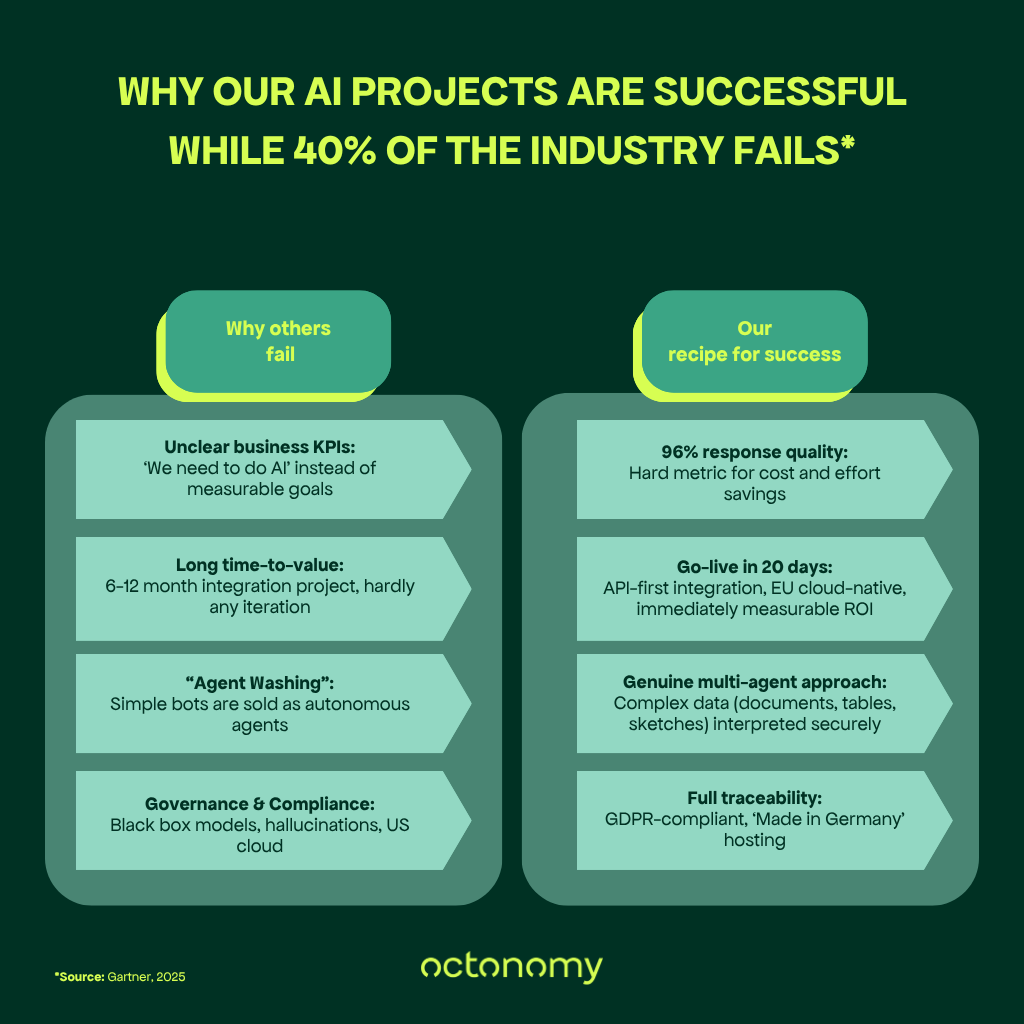
The State of AI in Customer Service 2025: The ultimate guide for IT decision-makers
In 2025, customer service will undergo a revolutionary transformation that goes far beyond simple chatbots. While technology is developing rapidly, IT decision-makers are faced with the complex challenge of distinguishing between short-lived trends and sustainable value creation. Current market data paints a fascinating picture of enormous potential and simultaneous pitfalls that make the difference between success and failure.
The 2025 reality of AI in customer service: between breakthrough & disillusionment
A comprehensive Capterra study of 2,307 customer service employees worldwide, including 187 from Germany, reveals the current market situation in all its complexity. 55 per cent of companies are already using AI functions in customer service, while at the same time there has been a remarkable increase in quality. Leading systems such as octonomy achieve a response quality of 96 per cent correct answers, a level of precision that puts traditional approaches in the shade.
However, the reality also has its downsides. Gartner recently predicted that over 40 per cent of Agentic AI projects will be cancelled by the end of 2027, mainly due to escalating costs, unclear business models and inadequate risk control. This discrepancy between potential and reality makes it clear that success is not a matter of course, but the result of strategic planning and careful implementation.
At the same time, Juniper Research confirms the market potential that has already been realised. Chatbots have achieved the projected annual cost savings of $11 billion for the retail, banking and healthcare sectors, while consumers and businesses together have saved over 2.5 billion hours on customer service enquiries. These figures underline the transformative power of technology that has moved from prediction to reality.
The evolution of chatbots in customer service
Why AI in customer service is more than just a trend
Modern AI in customer service is fundamentally different from its predecessors. While early chatbots were often frustratingly limited, today’s intelligent digital workforces are proactive and continuously learn from every interaction. The paradigm shift is comparable to the leap from landline phones to smartphones – both basically fulfil the same purpose, but the possibilities are revolutionarily expanded.
As a CTO or CIO, you know that technology alone does not solve problems. The strategic importance lies in seamless integration into existing processes and measurable added value. AI in customer service offers exactly that: a powerful, future-orientated workforce that fits organically into your IT landscape and at the same time intelligently automates operational challenges.
The figures speak for themselves. Customers with whom we work and who implement AI strategically report a reduction in average processing time of up to 70 per cent. But it goes far beyond speed. The quality of interaction reaches new dimensions, as modern AI systems deliver a response quality that not only meets human standards, but often exceeds them.
Increased efficiency through intelligent automation
The real revolution lies in the paradigm shift from reactive to proactive service. Instead of just reacting to requests, AI systems can anticipate potential problems and offer preventative solutions. A practical example from the field: the system recognises patterns in customer enquiries and proactively suggests solutions before the customer even realises that a problem could arise. This foresight is like a mechanic telling you that the brakes need to be changed soon, before you hear any squeaking noises.
The Capterra study impressively confirms this development. 61 per cent of respondents report a significant increase in productivity thanks to AI-supported customer service software. This efficiency manifests itself not only in speed, but also in the handling of call volumes – 45 per cent of companies report a significant increase in the number of enquiries handled while maintaining or even improving quality.
The implementation of AI in customer service is not a black box, but offers transparent, measurable results. Clear KPIs such as first contact resolution rate, average handling time and customer satisfaction score can be measured and optimised in real time. For example, a medium-sized company in the mechanical engineering sector was able to increase its first contact resolution rate from 45 to 89 per cent. This means fewer queries, more satisfied customers and noticeably relieved employees.
This increase in efficiency has a direct impact on service costs. Less manual intervention means lower personnel costs per ticket, while at the same time employee satisfaction increases. Teams can concentrate on really challenging cases instead of answering repetitive standard questions.
AI-based assistants at a glance
Scalability as a competitive advantage
Growth brings challenges that often overwhelm traditional customer service models. With AI in customer service, your service capacity automatically grows with your company. No more staff shortages in peak season, no more overloaded systems during product launches or marketing campaigns.
The flexibility of modern AI solutions is particularly evident in their adaptability. Do you suddenly need support in a new language? The AI learns the linguistic nuances within a few days. Are you launching a new product with specific support requirements? The system adapts the new processes organically. This agility is an enormous advantage, especially for medium-sized companies, which often have to react more quickly to market changes than large corporations.
Cost optimisation without loss of quality
The investment in AI in customer service typically amortises within 12 to 18 months. This impressive ROI performance is the result of a combination of several factors: reduced personnel costs, higher customer satisfaction with a lower churn rate and the ability to serve significantly more customers with the same team.
A concrete calculation example illustrates the potential: with an average of 10,000 customer enquiries per month and a cost saving of 3 euros per automated enquiry, we are talking about an annual saving of 360,000 euros. These figures are not theoretical, but are based on real implementations in various industries. Take a look at our ROI calculator.
The true costs in customer service are often hidden and only become visible when analysed more closely. Loss of knowledge due to employee turnover, inconsistent answers that lead to costly follow-up tickets, or the time employees spend searching for information. AI systematically eliminates these hidden cost drivers. Knowledge is stored centrally and available at all times, answers are consistent and of high quality, and information is found in milliseconds.
One financial services provider we work with reduced its service costs by 35 per cent simply by eliminating duplication and inconsistent processes. The system automatically recognised similar requests and used proven solutions instead of reinventing the wheel each time.

Seamless system integration
The best technology is useless if it cannot be harmoniously integrated into your existing IT landscape. Modern AI solutions for customer service are designed to adapt like a chameleon and communicate with a wide variety of systems.
Whether CRM, ERP or legacy ticketing system – AI in customer service speaks all digital languages. Thanks to standardised APIs and preconfigured connectors, integration is often a matter of days, not months. For you, this means no complex system migrations, no interruption to ongoing operations and no costly transition times. The AI docks seamlessly into your existing systems and immediately begins to deliver measurable added value.
Global availability and multilingualism
In a globalised world, 24/7 availability is not a luxury, but a basic requirement. Your customers don’t sleep, and geographical boundaries no longer matter in the digital age. With AI in customer service, you can offer first-class support around the clock, without costly night shifts or expensive on-call services.
The multilingualism of modern AI systems goes far beyond simple translations. They can easily handle 50 or more languages at native speaker level and understand cultural nuances and industry-specific terminology. A German SME recently expanded into Eastern Europe and, thanks to AI, was able to immediately offer support in six new languages without having to set up local service teams.
The quality of this multilingual communication is fundamentally different from automated translation tools. The AI understands context, cultural idiosyncrasies and responds not only in the right language, but also in the appropriate tone. This capability is particularly valuable for companies looking to tap into international markets without the complexity and cost of traditional localisation.
Data-driven insights for strategic decisions
AI in customer service acts as a continuous goldmine, mining valuable insights from every customer interaction. These insights go far beyond traditional service metrics and offer strategic perspectives for your entire organisation.
With predictive analytics, you can practically look into the future. AI analyses patterns in customer enquiries and predicts future trends with impressive accuracy. Is a product update imminent? The system tells you precisely which support requests you can expect. Are there seasonal fluctuations? The AI plans resources accordingly and automatically optimises capacities.
These strategic insights act as an early warning system for your company. By systematically analysing support requests, a software company discovered a critical bug that only occurred under very specific conditions. The system recognised the pattern before it became a widespread problem and enabled a proactive solution that prevented millions of euros in damage
Implementing AI in customer service: the path to an intelligent digital workforce
Successful AI implementations follow a proven pattern that minimises risk and maximises quick wins. The key lies in the strategic approach: Firstly, identify the biggest pain points in your current customer service. Typically, these are frequently asked questions or standard processes that take a lot of time but offer little added value.
These use cases are the first to be automated in order to achieve rapid success and create acceptance within the team. For example, a telecommunications provider started with the automation of contract questions and gradually expanded the system to include technical support and complaint management. After six months, 78 per cent of all enquiries were processed fully automatically, with consistently high customer satisfaction.
Involving your employees is crucial for success. They are not opponents of AI, but become strategic partners. The AI takes over the routine, while your experts can concentrate on really demanding, value-adding activities. This division of labour leads to higher job satisfaction, better results and an overall stronger team.
Challenges and solutions
The Capterra study mentioned above identifies loss of trust as the biggest challenge: 43 per cent of respondents see this as the main obstacle to successful AI implementations. Gaining and maintaining this trust requires transparency and a well thought-out communication strategy.
Customers need to understand when and how AI is being used. 58 per cent of companies already provide information about AI usage in their policies, while 55 per cent make reference to it during customer interactions. Freedom of choice is also important: 61 per cent of companies give customers the option to choose between AI and human support.
Data protection and compliance are a challenge for 36 per cent of implementations. The solution lies in choosing the right partner and consistently implementing data protection standards. 80 per cent of companies already train their employees in handling customer data in the context of AI software. Made-in-Germany solutions offer a particular advantage here, as they guarantee GDPR compliance from the ground up.
Technology is developing at breathtaking speed. Gartner predicts that 15 per cent of daily work decisions will be made autonomously by AI by 2028, while 33 per cent of enterprise software will contain AI functions. These figures illustrate the transformative power that extends far beyond customer service.
German companies expect 43 per cent of customer service enquiries to be fully automated in the next five years. At the same time, new roles and responsibilities for human employees are emerging, focussing on emotional intelligence, creative problem solving and strategic customer relationships.
Emerging technologies such as emotion recognition, augmented reality for visual support and the integration of IoT data for proactive service will further revolutionise the possibilities. AI in customer service is not a static solution, but a living system that is constantly learning and evolving. octonomy is also constantly evolving – read our release notes to find out what’s new.
Investing in AI is also an investment in the future viability of your company. While others are still struggling with outdated ticket systems, you are already positioning yourself at the forefront of digital transformation and offering your customers the service of tomorrow.
Frequently asked questions about AI in customer service
Veröffentlicht am 18. July 2025 von

Maren Kaspers
